Austin W. Perry was born in Upton, Massachusetts, to Sewall Perry and Annis Forbush, in 1829, just as the fledging music publishing business in the United States was starting to gain a small foothold, and many decades before it could be considered an industry. His sister Ann was born around 1836. The 1830 and 1840 enumerations showed the family living in Upton, all listed as free white citizens as per the official enumeration form of that time. Austin left home before 1850, and was not readily located in that year's enumeration.
Austin was married to Phebe Ann Butler in Boston in early September of 1853. Their first born was Paul Frederick, who lived only from 1856 to 1857, followed by Harry Sewell lived just a little longer, from 1857 to 1859. They were obviously trying to find a steady living situation somewhere around the country, as Philip Butler was born in 1859 in Iowa, the first of their children to survive infancy. The 1860 census showed the young family living some distance back toward the east in Jackson, Tennessee, lodging with the family of Grey French, with Austin engaged as a music teacher, but with no particular specialty specified. They soon returned to Boston, where their daughter Kate Austin "Kitty was born in 1864.
During the mid-1860s, Austin relocated west to Missouri, where his growing family was enumerated in 1870 in Saint Joseph, north of Kansas City. It was there that they had added a son, Andrew Jackson (undoubtedly named after the seventh U.S. President), in 1866. The 1870 record showed Austin working as a pension agent. In the early 1870s the Perry family migrated southeast to Pettis County, Missouri, settling in the expanding railroad and cattle town of Sedalia, Missouri, where they would remain.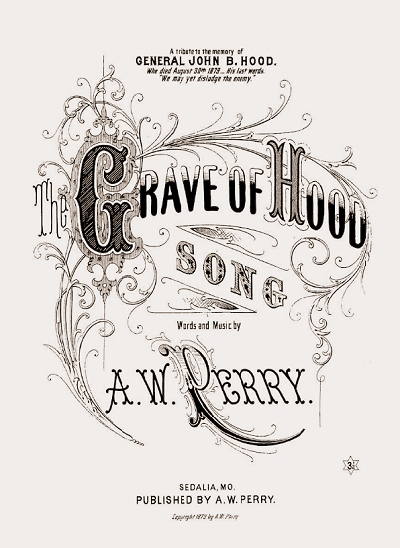 It was there that A.W. Perry opened his first music store around 1872 to 1873. He was advertising pianos and organs for sale as early as 1875 in the Sedalia Democrat. By the mid-1870s Perry was a major dealer for Mason and Hamlin musical instruments covering western and central Missouri, and even reaching into Arkansas and Texas as a traveling representative. His Sedalia store, which a teen-aged Philip was running in his absence by 1875, offered a variety of instruments and tuning services as well. The 1880 census showed Austin and Philip both engaged as music dealers in Sedalia, and they were listed in town records as A.W. Perry and Son.
It was there that A.W. Perry opened his first music store around 1872 to 1873. He was advertising pianos and organs for sale as early as 1875 in the Sedalia Democrat. By the mid-1870s Perry was a major dealer for Mason and Hamlin musical instruments covering western and central Missouri, and even reaching into Arkansas and Texas as a traveling representative. His Sedalia store, which a teen-aged Philip was running in his absence by 1875, offered a variety of instruments and tuning services as well. The 1880 census showed Austin and Philip both engaged as music dealers in Sedalia, and they were listed in town records as A.W. Perry and Son.
 It was there that A.W. Perry opened his first music store around 1872 to 1873. He was advertising pianos and organs for sale as early as 1875 in the Sedalia Democrat. By the mid-1870s Perry was a major dealer for Mason and Hamlin musical instruments covering western and central Missouri, and even reaching into Arkansas and Texas as a traveling representative. His Sedalia store, which a teen-aged Philip was running in his absence by 1875, offered a variety of instruments and tuning services as well. The 1880 census showed Austin and Philip both engaged as music dealers in Sedalia, and they were listed in town records as A.W. Perry and Son.
It was there that A.W. Perry opened his first music store around 1872 to 1873. He was advertising pianos and organs for sale as early as 1875 in the Sedalia Democrat. By the mid-1870s Perry was a major dealer for Mason and Hamlin musical instruments covering western and central Missouri, and even reaching into Arkansas and Texas as a traveling representative. His Sedalia store, which a teen-aged Philip was running in his absence by 1875, offered a variety of instruments and tuning services as well. The 1880 census showed Austin and Philip both engaged as music dealers in Sedalia, and they were listed in town records as A.W. Perry and Son.As early as 1879, there were mentions in the Sedalia Democrat that "Professor A.W. Perry, a composer of rare merit," was writing songs. One of his first known works from late 1879 was The Grave of Hood, a tribute to Civil War Confederate Lieutenant General John Bell Hood, who had recently died in New Orleans of yellow fever. It was likely his first overall publication under his own imprint. In early 1880 he followed with In Dreams I Am a Child Again. However, Austin's work seems to have had scant recognition in print over time, with the honors instead going to his first born. In 1880, now that he was established as a publisher, Austin began issuing works by Phil, including local interest pieces such as The First Regiment Grand March and the Queen City Guard's Grand March, based on Sedalia's acquired nick name.
While the initial publications from A.W. Perry & Son were products of nepotism, the idea of taking on other works and building a catalog was embraced relatively quickly, and within a very few years the firm became a viable alternative to the publishing outlets in nearby Kansas City. Most of the solo works from the 1880s were scored for either piano or parlor organ, with nothing terribly complex, but they were relatively melodic and original, with good typesetting. Some of the earliest Perry publications were received with a grain or more of salt, and not considered to be of the best possible quality, as noted in the Musical Critic and Trade Review of March 20, 1882:
Messrs. A. W. Perry & Son, of Sedalia, Mo., have the kindness to introduce us to the works of Albert Sauer. Oh, Albert, why write such sour things as "A Dream of the Past," and "Death of the Flowers?" Your "Paeonia" waltz, for piano or parlor organ, also pains us. It is one of those waltzes manufactured in a few hours and doomed to live about that long.
We find on the outside cover-page of the waltz examples of the first dozen or so measures of piano pieces published by A. W. Perry & Son. The titles are euphonious and cover a large ground. For instance, "Circus Parade Galop," "Cedar Brook Waltz," "Red Clover Blossoms Waltz." (Information entirely new to us.)
The most remarkable example, however, is the arrangement of the Sunday-school air, "Nearer, My God, to Thee," in six-eighth, the rhythm, however, not preventing it from being in waltz tempo, "Nearer, My God, to Thee," as a waltz, will not become popular. The arrangement is perpetrated by Q. Holshouser. Q, this is bad!
In contrast, one of Phil Perry's early works from 1883, Sambo's Double Shuffle, was a characteristic emulation of black music of that time (although they used the extremely unfortunate "nigger" reference in the text).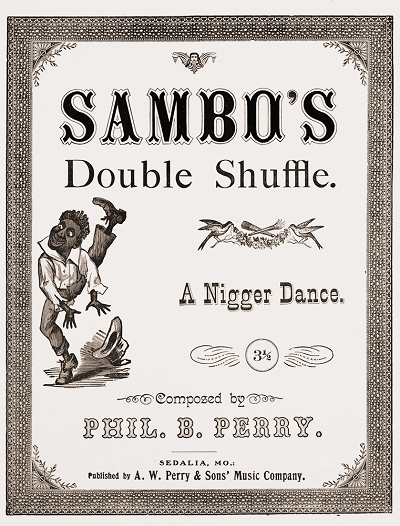 It was actually more representative than some may have thought, as there are not only hints of authentic negro music throughout, but one section near the end was clearly an early cakewalk in terms of both rhythmic patterns and melodic direction. Some of the melodies within were quoted from known sources, and the titles were included for those themes. If nothing else, this publication indicates the existence of this style of music in western Missouri more than a decade before it came to the forefront as a musical vogue of the late 1890s, and indicates that Phil actually had a pretty good ear for the music. This would play a role in the direction of the company in coming years.
It was actually more representative than some may have thought, as there are not only hints of authentic negro music throughout, but one section near the end was clearly an early cakewalk in terms of both rhythmic patterns and melodic direction. Some of the melodies within were quoted from known sources, and the titles were included for those themes. If nothing else, this publication indicates the existence of this style of music in western Missouri more than a decade before it came to the forefront as a musical vogue of the late 1890s, and indicates that Phil actually had a pretty good ear for the music. This would play a role in the direction of the company in coming years.
 It was actually more representative than some may have thought, as there are not only hints of authentic negro music throughout, but one section near the end was clearly an early cakewalk in terms of both rhythmic patterns and melodic direction. Some of the melodies within were quoted from known sources, and the titles were included for those themes. If nothing else, this publication indicates the existence of this style of music in western Missouri more than a decade before it came to the forefront as a musical vogue of the late 1890s, and indicates that Phil actually had a pretty good ear for the music. This would play a role in the direction of the company in coming years.
It was actually more representative than some may have thought, as there are not only hints of authentic negro music throughout, but one section near the end was clearly an early cakewalk in terms of both rhythmic patterns and melodic direction. Some of the melodies within were quoted from known sources, and the titles were included for those themes. If nothing else, this publication indicates the existence of this style of music in western Missouri more than a decade before it came to the forefront as a musical vogue of the late 1890s, and indicates that Phil actually had a pretty good ear for the music. This would play a role in the direction of the company in coming years.Perhaps more importantly during their early years in business, the Perrys established the Perry Musical Monthly Magazine in 1881, which had one of the longest continuous runs for a publication of its type by the time it ceased in the 1960s. It included simply scored pieces for piano or organ, plucked strings, and sometimes solo instruments. While many were composed by Phil, sometimes using pseudonyms such as M.W. Butler (based on his mother's maiden name), G. Gregory or G. Holocombe, the company also started acquiring older works, presenting them in arrangements that ranged from simple piano format to elaborate fantasias. A number of them were arranged by Phil, but within a few years other area composers and arrangers also made contributions to the company, including arrangements by composer Charles L. Johnson of Kansas City. At some point, it is probable that virtually everything that was accepted by the Perrys ended up in the magazine, some of them three or more times.
At some point in the early 1880s, Phil received additional musical training beyond what his father had likely imparted to him, studying abroad for brief periods in Germany and Austria, even having at least one of his works published in Vienna, the Jubelfest-Marsch. It would later be offered in a fully orchestrated form as well. Most of his early works under his own name were marches, often signifying some major event or dedicated to a local person or icon of some kind. Using pseudonyms allowed Phil to not only fatten the catalog with works seemingly by other composers, but to branch out in different styles as well, although many of his M.W. Butler pieces were also marches or two-steps in the 1880s and 1890s.
In the early 1880s, Phil's brother Andrew joined the firm, which was changed to A.W. Perry & Sons' Music Company, the name it would use until at least 1900. While still running their retail outlet in Sedalia, an effort to expand the music publishing business was undertaken by Phil in an increase in compositions and arrangements, some of them from older pieces that he freshened up a bit. They also created or adapted method books for piano, parlor organ (one of their specialties), and various other instruments. The Perry magazine would grow into national circulation by the early 1890s, thanks to good advertising in the trades and other places. Band and orchestral arrangements became a staple as well. On the personal side, Philip was married in 1888 to Berlin, Germany, native Marie von Weidemann. Their daughter Margaret was born on July 17, 1895. One other child would die in infancy. Andrew was married to Missouri native Clara Marie Jegglin in 1894, and their only daughter June was born in June of 1895.
The Perry firm also became an outlet for composers from throughout the Midwest, albeit most of them were from the Kansas City and Sedalia areas, and a relatively large number of them were female.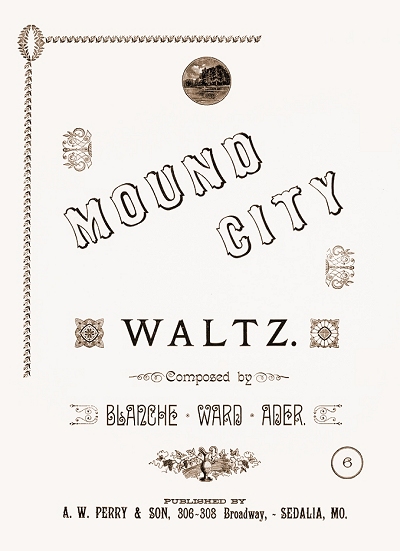 The Perry brothers evidently were depending on revenue from their magazine and local sales to cover acquisition and publication costs, because unlike a handful of publishers with similar output, they were not a song-poem firm, the type that charged the composer or lyricist to publish their piece. While little evidence was found to suggest this, they still may have done vanity runs for anybody who requested as such, probably for a minimum charge. But given their business model, these items would not have appeared under their imprint or in their magazine, more likely bearing the name of the composer or a patron. Even though a great deal of the Perry catalog over time consisted of less than exemplary work, and very little of it was beyond the scope of the average hobbyist pianist, there were a few gems embedded within, some of lasting value. Just the same, they did not take in quite everything they received, perhaps to their ultimate chagrin in one or more cases.
The Perry brothers evidently were depending on revenue from their magazine and local sales to cover acquisition and publication costs, because unlike a handful of publishers with similar output, they were not a song-poem firm, the type that charged the composer or lyricist to publish their piece. While little evidence was found to suggest this, they still may have done vanity runs for anybody who requested as such, probably for a minimum charge. But given their business model, these items would not have appeared under their imprint or in their magazine, more likely bearing the name of the composer or a patron. Even though a great deal of the Perry catalog over time consisted of less than exemplary work, and very little of it was beyond the scope of the average hobbyist pianist, there were a few gems embedded within, some of lasting value. Just the same, they did not take in quite everything they received, perhaps to their ultimate chagrin in one or more cases.
 The Perry brothers evidently were depending on revenue from their magazine and local sales to cover acquisition and publication costs, because unlike a handful of publishers with similar output, they were not a song-poem firm, the type that charged the composer or lyricist to publish their piece. While little evidence was found to suggest this, they still may have done vanity runs for anybody who requested as such, probably for a minimum charge. But given their business model, these items would not have appeared under their imprint or in their magazine, more likely bearing the name of the composer or a patron. Even though a great deal of the Perry catalog over time consisted of less than exemplary work, and very little of it was beyond the scope of the average hobbyist pianist, there were a few gems embedded within, some of lasting value. Just the same, they did not take in quite everything they received, perhaps to their ultimate chagrin in one or more cases.
The Perry brothers evidently were depending on revenue from their magazine and local sales to cover acquisition and publication costs, because unlike a handful of publishers with similar output, they were not a song-poem firm, the type that charged the composer or lyricist to publish their piece. While little evidence was found to suggest this, they still may have done vanity runs for anybody who requested as such, probably for a minimum charge. But given their business model, these items would not have appeared under their imprint or in their magazine, more likely bearing the name of the composer or a patron. Even though a great deal of the Perry catalog over time consisted of less than exemplary work, and very little of it was beyond the scope of the average hobbyist pianist, there were a few gems embedded within, some of lasting value. Just the same, they did not take in quite everything they received, perhaps to their ultimate chagrin in one or more cases.While competition in Kansas City was fierce by the late 1890s, and more so in the new century, 90 miles off in Sedalia proper the Perrys had the market for the most part, with a couple of other smaller firms doing business locally. The county seat of Pettis County, Sedalia, Missouri, which grew out of an army installation, and founded in part by Army General George Rappeen Smith, was a bustling town back then, being a railroad hub for the Missouri, Kansas and Texas Railroad (a.k.a. Katy Line), and a major cattle distribution center as well. In 1901 it also became the location of the Missouri State fair grounds. The population has ranged from between 15,000 and 24,000 over the past century, but has still been consistent. So supporting much more than two or three music stores in town was a stretch. Just the same, a good bit of competition arrived in town in the late 1880s, and would eventually become known as the home of a somewhat more famous and less prolific Sedalia publisher, even if a bit unfairly.
John Stillwell Stark brought his family to Sedalia around 1886. Having been a piano and organ salesman who also brought ice cream on his sales trips to farms throughout Missouri to help make instrument sales, he decided on a more permanent situation, and bought up Perry's major competitor, the J.W. Truxel music store on South Ohio Street. For the next decade and more Stark would do business as a musical instrument dealer, piano tuner, and instrument repairman. His involvement with sheet music was mostly as a sales outlet, although Stark had acquired several copyrights from Truxel when he bought the business, some dating back to the late 1870s.
When composer Scott Joplin came to town in the mid-1890s, he had already been published, but only a couple of songs and marches by that time.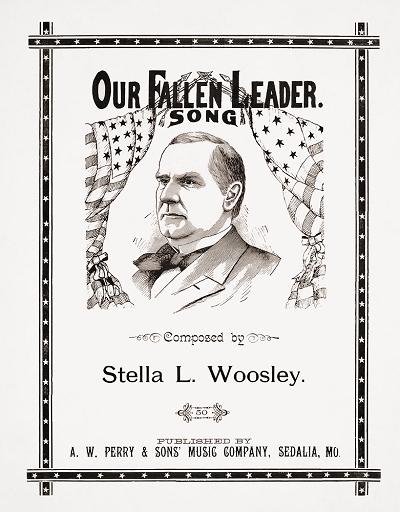 Joplin attended the George R. Smith College, which was geared toward the education of the black population, and learned advanced musical composition skills and notation among other things. In 1898 he shopped around one of his piano rags, likely starting in Sedalia, and ended up having it accepted by the Carl Hoffman firm in Kansas City, Missouri, who published it as Original Rags. Then, in 1899, Joplin wrote his iconic Maple Leaf Rag, dedicated to a local sporting club (a term used in some cases for a drinking establishment with piano entertainment) on Main Street. He may have shopped this around to the Kansas City publishers, and given his locality to the firm, there is little doubt it was also submitted to the Perrys, as Stark was not a publisher on a scale that even approached their output. For whatever reason, given that he was black (less than likely), or that it was too complex for them (certainly possible), or that their take on the future of ragtime was an uncertain one (also possible), the Perrys passed on the piece.
Joplin attended the George R. Smith College, which was geared toward the education of the black population, and learned advanced musical composition skills and notation among other things. In 1898 he shopped around one of his piano rags, likely starting in Sedalia, and ended up having it accepted by the Carl Hoffman firm in Kansas City, Missouri, who published it as Original Rags. Then, in 1899, Joplin wrote his iconic Maple Leaf Rag, dedicated to a local sporting club (a term used in some cases for a drinking establishment with piano entertainment) on Main Street. He may have shopped this around to the Kansas City publishers, and given his locality to the firm, there is little doubt it was also submitted to the Perrys, as Stark was not a publisher on a scale that even approached their output. For whatever reason, given that he was black (less than likely), or that it was too complex for them (certainly possible), or that their take on the future of ragtime was an uncertain one (also possible), the Perrys passed on the piece.
 Joplin attended the George R. Smith College, which was geared toward the education of the black population, and learned advanced musical composition skills and notation among other things. In 1898 he shopped around one of his piano rags, likely starting in Sedalia, and ended up having it accepted by the Carl Hoffman firm in Kansas City, Missouri, who published it as Original Rags. Then, in 1899, Joplin wrote his iconic Maple Leaf Rag, dedicated to a local sporting club (a term used in some cases for a drinking establishment with piano entertainment) on Main Street. He may have shopped this around to the Kansas City publishers, and given his locality to the firm, there is little doubt it was also submitted to the Perrys, as Stark was not a publisher on a scale that even approached their output. For whatever reason, given that he was black (less than likely), or that it was too complex for them (certainly possible), or that their take on the future of ragtime was an uncertain one (also possible), the Perrys passed on the piece.
Joplin attended the George R. Smith College, which was geared toward the education of the black population, and learned advanced musical composition skills and notation among other things. In 1898 he shopped around one of his piano rags, likely starting in Sedalia, and ended up having it accepted by the Carl Hoffman firm in Kansas City, Missouri, who published it as Original Rags. Then, in 1899, Joplin wrote his iconic Maple Leaf Rag, dedicated to a local sporting club (a term used in some cases for a drinking establishment with piano entertainment) on Main Street. He may have shopped this around to the Kansas City publishers, and given his locality to the firm, there is little doubt it was also submitted to the Perrys, as Stark was not a publisher on a scale that even approached their output. For whatever reason, given that he was black (less than likely), or that it was too complex for them (certainly possible), or that their take on the future of ragtime was an uncertain one (also possible), the Perrys passed on the piece.Joplin then approached Stark, who was not a full-fledged publisher per se, even though he had expanded his own acquired catalog slightly over the past decade. With the assistance of an attorney, Joplin was able to secure a deal for Maple Leaf Rag that allowed him a royalty for sales of the work. The quality of the rag, plus Stark's determination to make it a hit, worked out very well for both parties involved. Maple Leaf Rag would require more than a decade to reach the million sales mark, but its fame spread relatively quickly, to the point where John Stark moved his operation to the much larger city of Saint Louis, Missouri, in 1900. There focused more on the ownership of printing facilities and the publishing ragtime than on his Sedalia music store, which was now run by his son Will.
The initial edition of Maple Leaf Rag helped to put the name of Sedalia in front of the public, albeit more in the historic sense than during the ragtime era. Just the same, it may have had some affect on the Perrys. While they had included a smattering of ragtime-related works in their catalog over the years, this was "the one that got away." Yet the success of their magazine, which also included piano rags now and then, gave them an edge that John Stark did not have at that time. (He would eventually have his own monthly magazine for a few years, The Intermezzo, but not of the same scope or circulation).
The firm's founder, Austin Waite Perry, died on February 20, 1900 at age 70. In spite of his tenure in Sedalia, he was buried in Elmwood Cemetery in Kansas City. Philip Perry had left daily operations of the firm in 1895, and was living in Kansas City with his wife and son, working as a music teacher. He would remain there for the rest of his life, contributing as an arranger for the Perry firm as well as continuing to submit compositions.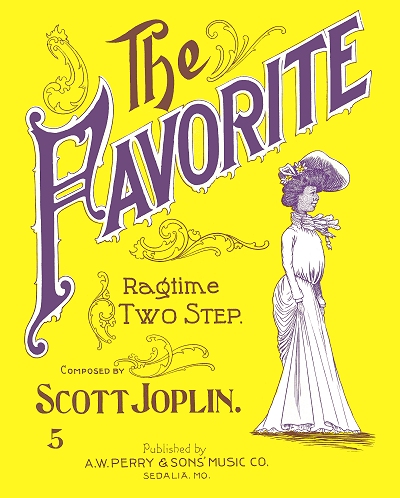 However, he did not work in a retail or sales capacity. That would be his brother's job. Andrew had ostensibly taken over the daily operations of the Perry company by the mid-1890s, including the retail store and the publishing arm, and may have been the one who passed on Maple Leaf Rag. He incorporated the firm in the state capital, Jefferson City, Missouri, during the month following his father's death. The 1900 census taken in Sedalia showed him as running the music house. Both brothers were well enough off that they each had a live-in household domestic. From around 1900 forward, the firm name would be A.W. Perry's Sons into the 1940s. As of the early 1900s they were doing their primary business from 306-308 W. Broadway (current day U.S. 50) at the corner of Kentucky Street, just a few blocks from downtown Sedalia.
However, he did not work in a retail or sales capacity. That would be his brother's job. Andrew had ostensibly taken over the daily operations of the Perry company by the mid-1890s, including the retail store and the publishing arm, and may have been the one who passed on Maple Leaf Rag. He incorporated the firm in the state capital, Jefferson City, Missouri, during the month following his father's death. The 1900 census taken in Sedalia showed him as running the music house. Both brothers were well enough off that they each had a live-in household domestic. From around 1900 forward, the firm name would be A.W. Perry's Sons into the 1940s. As of the early 1900s they were doing their primary business from 306-308 W. Broadway (current day U.S. 50) at the corner of Kentucky Street, just a few blocks from downtown Sedalia.
 However, he did not work in a retail or sales capacity. That would be his brother's job. Andrew had ostensibly taken over the daily operations of the Perry company by the mid-1890s, including the retail store and the publishing arm, and may have been the one who passed on Maple Leaf Rag. He incorporated the firm in the state capital, Jefferson City, Missouri, during the month following his father's death. The 1900 census taken in Sedalia showed him as running the music house. Both brothers were well enough off that they each had a live-in household domestic. From around 1900 forward, the firm name would be A.W. Perry's Sons into the 1940s. As of the early 1900s they were doing their primary business from 306-308 W. Broadway (current day U.S. 50) at the corner of Kentucky Street, just a few blocks from downtown Sedalia.
However, he did not work in a retail or sales capacity. That would be his brother's job. Andrew had ostensibly taken over the daily operations of the Perry company by the mid-1890s, including the retail store and the publishing arm, and may have been the one who passed on Maple Leaf Rag. He incorporated the firm in the state capital, Jefferson City, Missouri, during the month following his father's death. The 1900 census taken in Sedalia showed him as running the music house. Both brothers were well enough off that they each had a live-in household domestic. From around 1900 forward, the firm name would be A.W. Perry's Sons into the 1940s. As of the early 1900s they were doing their primary business from 306-308 W. Broadway (current day U.S. 50) at the corner of Kentucky Street, just a few blocks from downtown Sedalia.Trying to stay on top of the growing trend of ragtime, Andrew Perry and his staff did what they could to acquire some lesser syncopated works, both instrumentals an0d songs, and integrate them into the increasingly more gigantic catalog. In what may have been considered a minor but still important victory for the firm, they secured the publication of the first edition of Joplin's rag The Favorite, in 1904. There has been some considered speculation by historians that this piece may have actually been acquired by the firm in 1899 after the rejection of Maple Leaf Rag, and simply held back for five years. This might also be reinforced by the fact that Joplin had spent much of 1901 to 1904 based in Saint Louis, or traveling around the Midwest. However, given that he returned to Sedalia in 1904 with his new bride, Freddie Alexander (who would sadly die there that summer), around the same time as the piece was copyrighted, it is possible that Joplin had been sitting on it instead, then sold it to them at that time to help defray his expenses for his upcoming stay in town. That the cover features a woman, possibly African American, and not a horse, which the title would more readily suggest, is another curiosity. Either way, the Perry company now had a Joplin piece in their repertoire, and in later decades would add a few more through acquisitions of the catalogs of other publishers.
The firm's main promotion vehicle over the next two decades remained their monthly magazine, which at one point in October of 1906 was in turn given a bit of a side-swipe promotion by the Music Trade Review, based on Perry's own somewhat over-promising blurb:
As a local print has it, "Sedalia is recognized as the center of musical industry and enterprise in the Middle West." This thriving burg being in the "show me" State further comment is unnecessary, excepting to add that their home journal, besides speaking of A. W. Perry & Sons Music Co.'s "name and reputation being familiar to nearly all lovers of music in this country," also state they are the "publishers of a monthly magazine known as Perry's Musical Magazine, which goes into thousands of music-loving homes annually. This magazine gives promise of attaining a circulation unequalled by any other similar musical magazine." Nothing like having a friend at court.
In truth, The Etude published by Theodore Presser in Philadelphia would ultimately win the prize for the most durable and widely circulated music-focused periodical,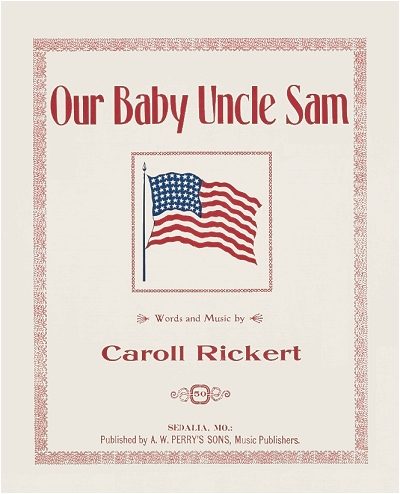 but Perry's was certainly in the top five during the early years of the century, and over the decades they would prove it to be the one that refused to die for a long time, even when recycling material from years past. Locally, as the Stark store eventually relocated to Saint Louis, there was only one major competitor, the music house of S.R. Payne. However, they did not publish as Perry did, so only the storefront and musical instrument maintenance fields were really where the competition was, and in a town of nearly 20,000, there was enough work to go around. The substantial firm of J.W. Jenkins' Sons from Kansas city also offered some threat of competition, opening up branches in some western Missouri cities, and even sending around traveling representatives, but their presence in Sedalia proper was reportedly limited.
but Perry's was certainly in the top five during the early years of the century, and over the decades they would prove it to be the one that refused to die for a long time, even when recycling material from years past. Locally, as the Stark store eventually relocated to Saint Louis, there was only one major competitor, the music house of S.R. Payne. However, they did not publish as Perry did, so only the storefront and musical instrument maintenance fields were really where the competition was, and in a town of nearly 20,000, there was enough work to go around. The substantial firm of J.W. Jenkins' Sons from Kansas city also offered some threat of competition, opening up branches in some western Missouri cities, and even sending around traveling representatives, but their presence in Sedalia proper was reportedly limited.
 but Perry's was certainly in the top five during the early years of the century, and over the decades they would prove it to be the one that refused to die for a long time, even when recycling material from years past. Locally, as the Stark store eventually relocated to Saint Louis, there was only one major competitor, the music house of S.R. Payne. However, they did not publish as Perry did, so only the storefront and musical instrument maintenance fields were really where the competition was, and in a town of nearly 20,000, there was enough work to go around. The substantial firm of J.W. Jenkins' Sons from Kansas city also offered some threat of competition, opening up branches in some western Missouri cities, and even sending around traveling representatives, but their presence in Sedalia proper was reportedly limited.
but Perry's was certainly in the top five during the early years of the century, and over the decades they would prove it to be the one that refused to die for a long time, even when recycling material from years past. Locally, as the Stark store eventually relocated to Saint Louis, there was only one major competitor, the music house of S.R. Payne. However, they did not publish as Perry did, so only the storefront and musical instrument maintenance fields were really where the competition was, and in a town of nearly 20,000, there was enough work to go around. The substantial firm of J.W. Jenkins' Sons from Kansas city also offered some threat of competition, opening up branches in some western Missouri cities, and even sending around traveling representatives, but their presence in Sedalia proper was reportedly limited.The 1910 enumeration taken in Sedalia showed Andrew as a music publisher rather than a music store owner, and in addition to Clara and June, Clara's brother Raymond was residing in their home. To the west in Kansas city, Philip listed himself as a professor of music, although it is unclear if he was teaching anywhere else except for a private downtown studio on Main Street. In some Kansas City directories of the 1910s he was also listed as a music publisher. Business as usual continued into the 1930s with no extraordinary stories forthcoming from the Perrys - only the usual stream of reprints and new pieces that frankly ranged from mediocre to a level above marginally good, which actually served many of their customers quite well in a time when fancy piano playing and jazz instrumentals were making music playing and notation even more challenging than when ragtime first took over. The 1920 census read pretty much the same as 1910 for both brothers, as did the enumeration taken in 1930.
During the 1920s, the music publishing business was booming in the east and Midwest, but only marginally in Missouri. Competition from player pianos had put somewhat of a dent in the business in the 1910s, but it compensated during World War I and recovered nicely. However, as the 1930s approached, improvements in phonograph technology and the increasing scope of radio again affected sheet music sales for all but the latest hits or instructional materials. In that regard, less than half of the extant Perry catalog was viable by late in the decade, and while pieces did not remain in print individually, many were re-copyrighted and included in the monthly or an occasional folio. There is no clear indication that the Perry store in Sedalia branched into the phonograph or radio business as Payne had, so they were quickly becoming old school by the time the Great Depression took hold in the early 1930s. Just the same, Andrew and Philip stayed the course, primarily with their magazine and the instrument store on Broadway.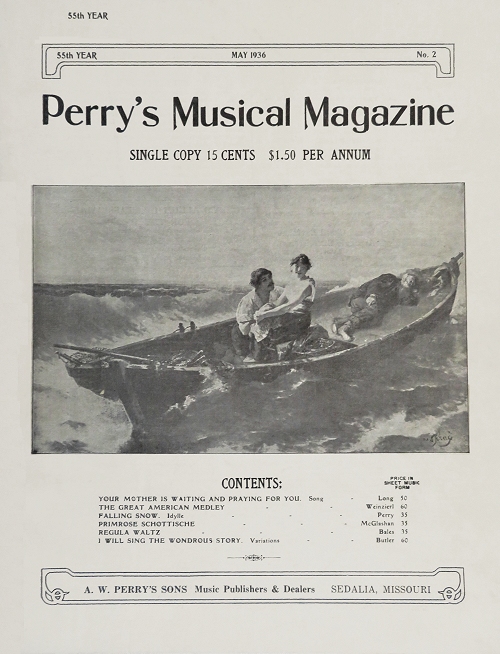 The 1940 census read much as 1930 had, with Andrew, now 72, still listed as the owner of a music publishing firm, and Philip, now nearing 81, still teaching music in Kansas City. But it would soon be time for a new generation to take over the business.
The 1940 census read much as 1930 had, with Andrew, now 72, still listed as the owner of a music publishing firm, and Philip, now nearing 81, still teaching music in Kansas City. But it would soon be time for a new generation to take over the business.
 The 1940 census read much as 1930 had, with Andrew, now 72, still listed as the owner of a music publishing firm, and Philip, now nearing 81, still teaching music in Kansas City. But it would soon be time for a new generation to take over the business.
The 1940 census read much as 1930 had, with Andrew, now 72, still listed as the owner of a music publishing firm, and Philip, now nearing 81, still teaching music in Kansas City. But it would soon be time for a new generation to take over the business.Phil's daughter Margaret had married Warner Albert Cory in January of 1918. The 1920 and 1930 censuses showed Warner to be mortgage or stock broker. Two children were born to the couple, including Virginia Margaret (8/1/1919) and Warner A. Jr. (3/7/1928). Margaret died of breast cancer on August 28, 1936. By the time of the 1940 census, Warner had remarried and moved to New York with his son, working as the sales manager for a food products company. It appears that Virginia remained behind in Kansas, living with her grandparents for a while as she completed her schooling. She was living on her own for the 1940 census. On December 26, 1940, Virginia was married to Bert Veeder Helms in Kansas City.
It is possible that she was poised to help run the business during the revitalizing era of the 1940s, and was soon commuting to Sedalia to learn more about it. Her uncle, Andrew Jackson Perry, died on June 10, 1945, of bronchial pneumonia and influenza. Philip, now around 86, apparently had little interest in engaging in the business any longer. So Virginia, with some assistance from the existing staff and her husband, took over what was by now simply A.W. Perry Music, and kept it afloat during the post-war years. Late in the decade she was joined by her younger brother, Warner, Jr. Their aunt Clara Perry died on February 8, 1948, in the Bothwell Hospital in Sedalia, the result of a stroke. Marie Perry passed on in Kansas City on September 6, 1951, from heart disease. Finally, the longest-lived and most venerable of the Perry clan, Philip B. Perry, passed on in the Elms Nursing Home in Kansas City on February 9, 1953, one day short of the 53rd anniversary of his father's death, at 93 years of age. He was laid to rest near his father in Elmwood Cemetery in Kansas City.
While the music store became a secondary concern and finally no storefront at all, the publishing portion of A.W. Perry was carried on from Kansas City by Virginia and Warner in the guise of the monthly magazine, albeit with only minimal new material, and some folio reprints of their catalogs. For the most part, the effort was administrative for the heirs, who had printers and clerical works to take care other portions of the business. By the late 1950s that was entirely mail order, and mostly legacy customers at that. Warner, keeping it in the family, married a cousin, Winifred L. Perry, on February 26th, 1955. The Perry family finally called it quits with one final edition of the Perry Musical Magazine in early 1967, then closed a chapter in Missouri musical history that had lasted for the better part of a century. Virginia Perry Helms died in Kansas City on April 12, 1991. Warner A. Cory Jr. followed on December 3, 1996.


 Selected Published Composers
Selected Published Composers